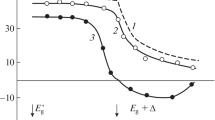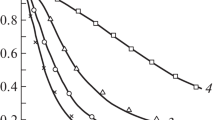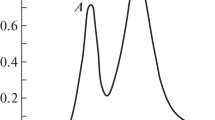Optical orientation, meaning the preferred orientation of the electron spin upon absorption of polarized light, is one of the most fruitful methods of spectroscopy and is extensively used for the investigation of atoms and ions [1]. Observation of optical orientation in a semiconducting crystal would make it possible to use the methods developed in atomic spectroscopy to investigate semiconductors and particularly to perform accurate measurements of the lifetime, the spin-relaxation time, the carrier g-factors, etc. So far, however, only one communication was published reporting such investigations in semiconducting crystals [2].
Similar content being viewed by others
Avoid common mistakes on your manuscript.
We report here observation of optical orientation of free carriers in GaxAll – x crystals upon excitation of the electrons by circularly-polarized light (σ±) from the valence band into the conduction band. The degree of orientation was determined from the polarization of the recombination radiation. The investigations were performed on n-type and p-type material at 4.2 and 77 K. In particular, an appreciable degree of electron orientation (0.46 ± 0.06) was obtained for the p-type material, and the lifetime of the electrons in the conduction band, τ = (1.2 ± 0.2) × 10–10 s, was determined from the depolarization of the luminescence in a transverse magnetic field.
The luminescence was excited with an He–Ne laser (hν = 1.959 eV). The composition of the mixed crystals (x \( \simeq \) 0.7) was chosen such as to make the laser radiation fall in the region of the interband transitions near the intrinsic-absorption edge. The degree of luminescence polarization, S = |(\({{I}_{{{{\sigma }^{ + }}}}}\) – \({{I}_{{{{\sigma }^{ - }}}}}\))/(\({{I}_{{{{\sigma }^{ + }}}}}\) + \({{I}_{{{{\sigma }^{ - }}}}}\))| (where \({{I}_{{{{\sigma }^{ \pm }}}}}\) is the radiation intensity for the polarization σ+ or σ–) and it was measured with the aid of special modulator, namely a rotating quarter-wave plate. In all the experiments a value S ≠ 0 was observed only when the excitation was by circularly-polarized light. In the differential spectrum (\({{I}_{{{{\sigma }^{ + }}}}}\) – \({{I}_{{{{\sigma }^{ - }}}}}\)), the sign of the signal changed in this case when the polarization of the exciting light changed from σ+ to σ–.
In the spectrum of the p-type crystals (Zn ~ 1017 cm–3) at 4.2 and 77 K there is observed one luminescence band due to transitions to the shallow acceptor (Ei \( \simeq \) 0.03 eV). The position of the band in mixed crystals changed in accordance with the change of the composition and was at 1.89 and 1.91 eV in the investigated samples. It was observed that the luminescence was strongly polarized following excitation with circularly polarized light, the degree of polarization remaining constant over the entire band. At 77 K, the degree of polarization for both samples was S = 0.23 ± 0.03.
The appreciable luminescence polarization shows that in this case the free electrons produced by the light were effectively oriented. The effect of optical polarization of the holes can be neglected since the total number of holes in p-type material is much larger than the number of holes produced by the light. The degree of orientation (P) is defined as P = | (n+1/2 – n–1/2)/(n+1/2 + n–1/2)|, where n±1/2 is the number of electrons with spin parallel or antiparallel to the propagation direction of the exciting light. In the presence of relaxation we have
where τ is the lifetime of the electron, T1 is the relaxation time of the electron spin, and P0 is the maximum degree of orientation and is determined by the probability of transitions in which electrons with spin +1/2 or –1/2 are produced upon absorption of circularly polarized light. The band structure of the Ga0.7Al0.3As crystal is the same as that of the GaAs crystal. P0 = 0.5 for the interband transitions (Γ3/2–Γ1/2), in accordance with the known selection rules. In the effective mass approximation, the probabilities of recombination transitions in which shallow impurities take part are equal to those of the interband transitions. In this case the degree of luminescence polarization in the recombination of oriented electrons should equal S = 0.5P.
It follows from the measured values of the degree of polarization that the electron orientation reached in our experiments, P = 0.46 ± 0.06, is close to the maximal degree P0 = 0.5. This shows that τ/T1 \( \ll \) 1 in the investigated crystals, i.e., the spin relaxation time T1 greatly exceeds (by at least 3 or 4 times) the lifetime τ.
For the investigated samples, the quantum energy of the exciting light exceeded the width of the forbidden band by 0.02 and 0.04 eV. Consequently, the oriented electrons produced by the light relaxed to the bottom of the conduction band. The observed high degree of polarization indicates that in this case the relaxation of the electron energy was not accompanied by spin relaxation.
The electron lifetime τ can be determined from the depolarization of the luminescence in a transverse magnetic field [1]. The dependence of the degree of polarization on the magnetic field has a Lorentz form
where ωL is the frequency of the classical Larmor precession, g is the electron g-factor, T1M is the lifetime of the magnetic moment, l/TM = l/T1 + l/τ. Inasmuch as in our case τ/T1 \( \ll \) l, the time T1M determined from the magnetic measurements is practically equal to τ. The value of the electron g-factor in GaAs is 0.5 [3], and for the mixed Ga0.7Al0.3As crystal, with account taken of the band parameters [4], we can estimate that g = 1.0.
Line a in Fig. l shows that the observed decrease of the polarization with increasing magnetic field is well described by a Lorentz contour with half-width 1200 G, yielding a lifetime τ = (1.2 ± 0.2) × 10–10 s. This value agrees with the estimates of the lifetime of the minority carriers (10–10–10–12 s) obtained in the investigation of transport phenomena in such crystals as p‑GaAs [5].

Fig. 1. Dependence of the degree of luminescence polarization S on the transverse field in a p-type crystal at T = (a) 77 and (b) 4.2 K. The solid curves represent Lorentz contours with widths (a) 1200 and (b) 800 G.
Thus, observation of optical orientation makes it possible to measure relatively simple short carrier lifetimes, something impossible to do with sufficient accuracy by other methods.
At 4.2 K, a lower degree of polarization was observed in the same crystals, S = 0.10 ± 0.02, and measurements in the magnetic field (line b in Fig. l) yielded T1M = (1.8 ± 0.03) × 10–10 s. The decrease of the degree of orientation of the electrons at 4.2 K can be due either to an increase of the ratio τ/T1 or to the fact that at 4.2 K the recombination proceeds not from the bottom of the conduction band, but from the donor level, and in the case of band-level relaxation the electron orientation is partially lost.
In n-type material at 4.2 K, we also obtained an appreciable carrier orientation. The spectrum of these crystals at 4.2 K shows two emission bands (Fig. 2a): band A lies near the absorption edge and is due to transitions in which a shallow donor or exciton takes place, and band В is connected with transition to a shallow acceptor. The degrees of polarization for these bands (Fig. 2) differ greatly: S = 0.11 ± 0.03 for band A and S = 0.06 ± 0.03 for band B. We also observed for these crystals depolarization of the luminescence in a transverse magnetic field (T1M \( \simeq \) 10–10 s), but in view of the weakness of the signals, the lifetime was not measured accurately.

Fig. 2. Polarized luminescence in n-type crystals at 4.2 K: (a) luminescence spectrum, (b) differential (\({{I}_{{{{\sigma }^{ + }}}}}\) – \({{I}_{{{{\sigma }^{ - }}}}}\)) spectrum of the radiation polarization of the same sample upon excitation with circularly polarized light σ+.
REFERENCES
C. Cohen-Tannoudji and A. Kastler, Prog. Opt. 5, 33 (1966).
R. R. Parsons, Phys. Rev. Lett. 23, 1152 (1969).
W. Dunkan and E. E. Schneider, Phys. Lett. 7, 23 (1963).
L. Roth, B. Lax, and S. Zwerdling, Phys. Rev. 114, 90 (1959).
V. G. Kustov and V. I. Orlov, Sov. Phys. Semicond. 3, 1457 (1970).
ACKNOWLEDGMENTS
We wish to thank Zh.I. Alferov, D.Z. Garbuzov, O.A. Nlnua, and V.G. Trofimov for supplying the crystals with the measured luminescence spectra and for support, and to M.I. D’yakonov for useful discussion.
Funding
This work was supported by ongoing institutional funding. No additional grants to carry out or direct this particular research were obtained.
Author information
Authors and Affiliations
Corresponding author
Ethics declarations
The authors of this work declare that they have no conflicts of interest.
Additional information
Publisher’s Note.
Pleiades Publishing remains neutral with regard to jurisdictional claims in published maps and institutional affiliations.
Rights and permissions
Open Access. This article is licensed under a Creative Commons Attribution 4.0 International License, which permits use, sharing, adaptation, distribution and reproduction in any medium or format, as long as you give appropriate credit to the original author(s) and the source, provide a link to the Creative Commons license, and indicate if changes were made. The images or other third party material in this article are included in the article’s Creative Commons license, unless indicated otherwise in a credit line to the material. If material is not included in the article’s Creative Commons license and your intended use is not permitted by statutory regulation or exceeds the permitted use, you will need to obtain permission directly from the copyright holder. To view a copy of this license, visit http://creativecommons.org/licenses/by/4.0/.
About this article
Cite this article
Ekimov, A., Safarov, V. Optical Orientation of Carriers in Interband Transitions in Semiconductors. Jetp Lett. 118 (Suppl 1), S38–S40 (2023). https://doi.org/10.1134/S0021364023130076
Received:
Revised:
Accepted:
Published:
Issue Date:
DOI: https://doi.org/10.1134/S0021364023130076




